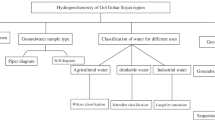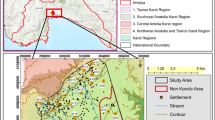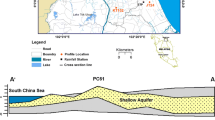Abstract
This paper discusses the issue and potential influences of miss-assignment of groundwater table in the analysis of soil liquefaction. In viewing that the groundwater table (\( \varvec{GWT}_{0} \)) during subsurface exploration or testing for evaluating cyclic resistance ratio (\( \varvec{CRR} \)) of soils is sometimes mistakenly assumed the same as the groundwater table (\( \varvec{GWT} \)) for computing cyclic stress ratio (\( \varvec{CSR} \)) due to seismic shaking, the results of liquefaction analysis may thus be erroneous. If the \( \varvec{GWT}_{0} \) is assigned higher than the actual level, the \( \varvec{CRR} \) and the associated factor of safety (\( \varvec{F}_{\varvec{L}} \)), would be overly predicted. Alternatively, if the \( \varvec{GWT}_{0} \) is assigned lower than its actual one, the \( \varvec{CRR} \) and \( \varvec{F}_{\varvec{L}} \) would be underestimated. If the groundwater table during exploration or testing is mistakenly assigned the same as the groundwater table for computing cyclic stress ratio (i.e., \( \varvec{GWT}_{0} = \varvec{GWT} \); or “one-groundwater-table, \( \varvec{OGT} \), scenario”), then the variation in the groundwater tables will lead to the changes in \( \varvec{CRR} \) and \( \varvec{CSR} \) in the same sense. Owing to different rates of change, however, the computed factor of safety (\( \varvec{F}_{\varvec{L}} = \varvec{CRR}/\varvec{CSR} \)), and the associated liquefaction potential index (\( \varvec{LPI} \)), may sometimes result in an unexpected situation. Namely, a rise in the groundwater tables would cause an unanticipated increase in the computed factor of safety and a decrease in the associated liquefaction potential index. Based on results of current study with assumption of \( \varvec{OGT} \) scenario, the \( \varvec{LPI} \) could be reduced by 10–30% if \( \varvec{GWT}_{0} \) is 3 m higher than the actual level; or alternatively, the \( \varvec{LPI} \) would be increased by 5–45% if \( \varvec{GWT}_{0} \) is 3 m lower than the actual one.
Access this chapter
Tax calculation will be finalised at checkout
Purchases are for personal use only
Similar content being viewed by others
References
Andrus, R.D., Stokoe, K.H., II. Liquefaction resistance of soils from shear-wave velocity. J. Geotech. Geoenvir. Eng. ASCE 126(11), 1015–1025 (2000)
Chang, M., Kuo, C.P., Shau, S.H., Hsu, R.E.: Comparison of SPT-N-based analysis methods in evaluation of liquefaction potential during the 1999 Chi-chi Earthquake in Taiwan. Comput. Geotech. 38(3), 393–406 (2011)
Iwasaki, T., Tokida, K., Tatsuoka, F., Watanabe, S., Yasuda, S., Sato, H.: Microzonation for soil liquefaction potential using simplified methods. In: The 3rd International Earthquake Microzonation Conference, Seattle, vol. 3, pp. 1319–1330 (June–July 1982)
Lin, M.L., Chen, M.H., Shen, C.C.: Establishment of national liquefaction potential maps and assessment of liquefaction analysis methods in Taiwan. Report of NCREE, Taiwan, No. NCREE-01–17. (in Chinese with English Abstract) (2001)
Ministry of the Interior (MOI), Taiwan, Earthquake resistance design of structures – codes and explanations, by Construction and Planning Agency, Taiwan, promulgated on 19 Jan 2011. (in Chinese) (2011)
Ministry of the Interior (MOI), Taiwan. Design code for structure foundations (Draft), by Architecture and Building Research Institute, Taiwan, proposed in October 2017. (in Chinese) (2017)
Resources Engineering Inc. (REI). Report on field investigation and liquefaction potential assessment for enhancement of precision-scale of soil liquefaction potential maps. Yunlin County Mid-Precision Liquefaction Potential Maps and Liquefiable Ground Mitigation Demonstration Project (Phase I), for Yunlin County Government, Taiwan. (in Chinese) (2019)
Robertson, P.K., Wride, C.E.: Evaluating cyclic liquefaction potential using the cone penetration test. Can. Geotech. J. Ottawa 35(3), 442–459 (1998)
Seed, H.B., Tokimatsu, K., Harder, L.F., Chung, R.M.: The influence of SPT procedures in soil liquefaction resistance evaluations. J. Geotech. Eng. ASCE 111(12), 1425–1445 (1985)
Wang, J.S., Lu, C.C., Hwang, J.H., Huang, H.L.: The influence of the use of single ground water level on soil liquefaction assessment: a case study of Taipei basin. The 8th Japan-Taiwan Joint Workshop on Geotechnical Hazards from Large Earthquakes and Heavy Rainfalls, Kyoto, Japan, pp. 37–38 (October 2019)
Youd, T.L., Idriss, I.M., Andrus, R.D., Arange, I., Castro, G., Christian, J.T., Dobry, R., Liam Finn, W.D., Harder Jr., L.F., Hynes, M.E., Ishihara, K., Koester, J.P., Liao, S.S.C., Marcuson III, W.F., Martin, G.R., Mitchell, J.K., Moriwaki, Y., Power, M.S., Robertson, P.K., Seed, R.B., Stokoe II, K.H.: Liquefaction resistance of soils: summary report from the 1996 NCEER and 1998 NCEER/NSF workshops on evaluation of liquefaction resistance of soils. J. Geotech. Geoenvir. Engrg. ASCE 127(10), 817–833 (2001)
Acknowledgement
The authors would like to thank following peoples for discussions on the issue of one-groundwater-table in liquefaction analysis of soils: Professor T.S. Ueng of NTU, Taiwan, Professors C.H. Chen and J.H. Hwang of NCREE, Taiwan, Dr. C.C. Lu of NCREE, Taiwan, Mr. C.H. Wang of MAA, Taiwan, and the participants of 07/2018 NCREE seminar on the groundwater table issue for soil liquefaction. The opinions and insights provided through these discussions had been valuable and helpful in clarification of the issue that often times being neglected. The authors would also like to thank the Government of Yunlin County to provide borehole data for verification of the issue.
Author information
Authors and Affiliations
Corresponding author
Editor information
Editors and Affiliations
Rights and permissions
Copyright information
© 2021 The Editor(s) (if applicable) and The Author(s), under exclusive license to Springer Nature Switzerland AG
About this paper
Cite this paper
Chang, M., Chan, MS., Huang, RC., Upomo, T.C., Kusumawardani, R. (2021). Assignment of Groundwater Table in Liquefaction Analysis of Soils. In: Shehata, H., Badr, M. (eds) Advancements in Geotechnical Engineering. Sustainable Civil Infrastructures. Springer, Cham. https://doi.org/10.1007/978-3-030-62908-3_1
Download citation
DOI: https://doi.org/10.1007/978-3-030-62908-3_1
Published:
Publisher Name: Springer, Cham
Print ISBN: 978-3-030-62907-6
Online ISBN: 978-3-030-62908-3
eBook Packages: EngineeringEngineering (R0)




